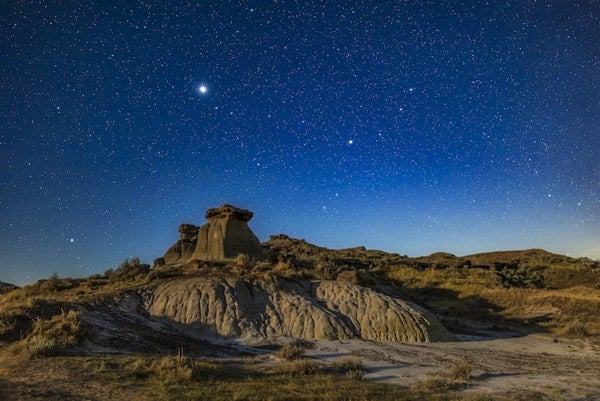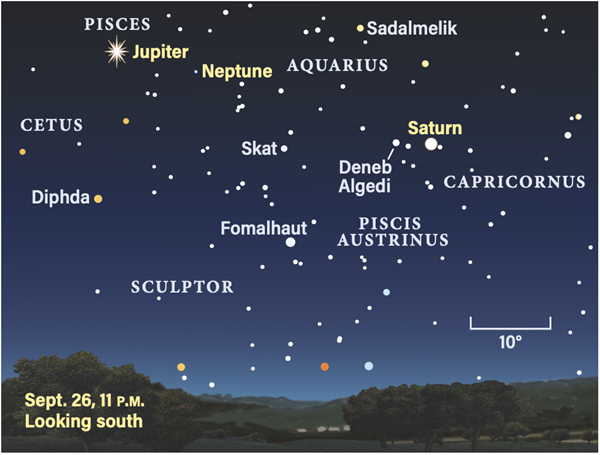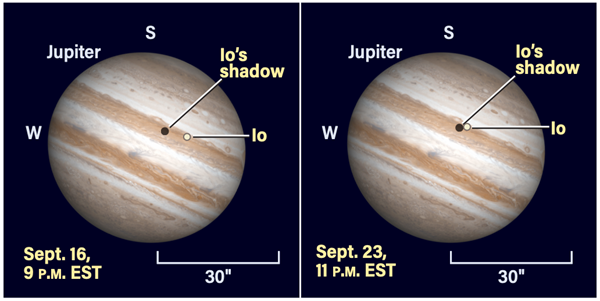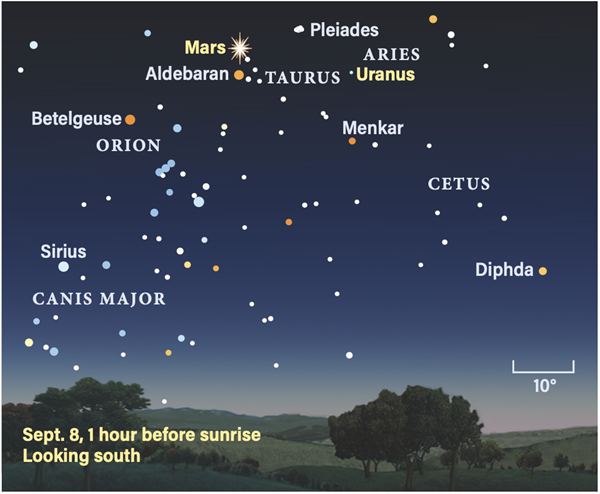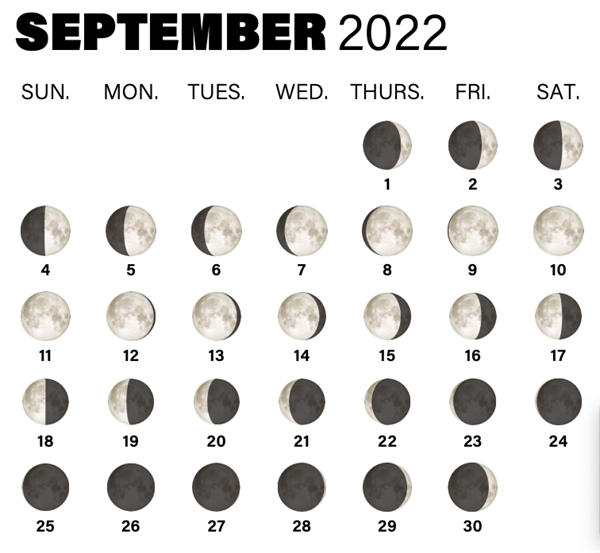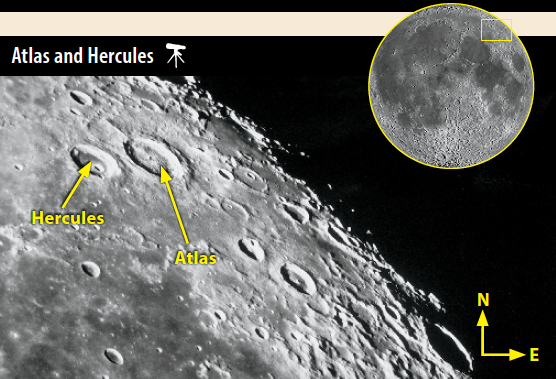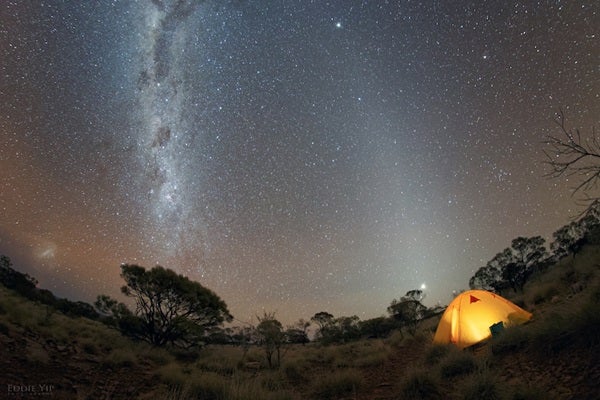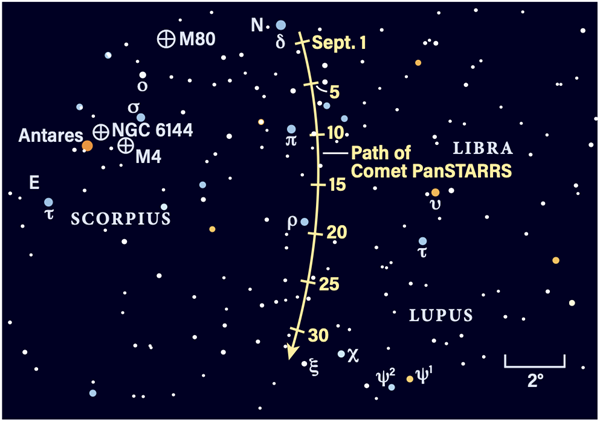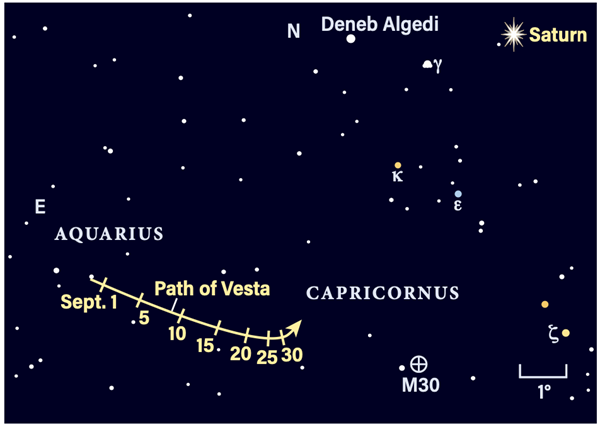Jupiter is at its best all month, reaching opposition in late September. Saturn puts on a great evening show, along with a brief view of elusive Mercury soon after sunset. For early risers, the morning sky carries a growing Mars as its main planetary focus, while early in the month you can catch Venus in the bright morning twilight.
Mercury hugs the western horizon during the first two weeks of September, poorly placed for Northern Hemisphere observers. It is also fading, shining at magnitude 0.4 on Sept. 1 and setting 50 minutes after the Sun. Try to spot the planet 3° high at 8 P.M. local time. If your sky is clear and transparent enough to see Arcturus shining through twilight 40° above the horizon, drop straight down to find the approximate location of Mercury. By Sept. 5, Mercury’s brightness dims to 0.6 and it drops to 3° altitude within 20 minutes of sunset. Southern Hemisphere observers have a better time following the planet this time around.
The early evening is dominated by Saturn’s appearance in the southeastern sky as darkness falls. It’s now a month past opposition. On Sept. 7 and 8, a gibbous Moon stands near the ringed planet. Saturn is 20° high by 9 P.M. local time in early September. It glows at magnitude 0.3 in western Capricornus the Sea Goat, outshining 1st-magnitude Fomalhaut 24° to its southeast.
Follow Saturn all evening as it climbs higher; it shows off best when it is 35° high in the southern sky, around local midnight. Telescopic views reveal the magnificent ring system, visible even in the smallest scope. The apparent tilt of the rings increases to 15° by Sept. 30, slightly better than the 12° tilt over the summer. Overall, this angle is declining as Saturn moves along its orbit; such variations are the result of the way Saturn’s orbit is tilted with respect to Earth’s by 2.5°.
Saturn’s disk remains near its peak diameter of 18″ across the equator, with a polar diameter of 16.5″. The rings span 42″ across the major axis and only 10″ across the minor axis. By 2025, they will appear edge-on.
Titan, Saturn’s largest moon, is magnitude 8.5, an easy target for small telescopes. You’ll find it north of Saturn early on Sept. 6 and 22, and due south Sept. 14 and 30. It lies due east of the planet on Sept. 25. Inside Titan’s orbit are many more moons, all fainter. Tethys, Dione, and Rhea shine at 10th magnitude and orbit every two to five days.
Iapetus passed superior conjunction in late August and now heads to a Sept. 15 eastern elongation, when it appears faintest — about 12th magnitude — nearly 9′ due east of Saturn.
Neptune reaches opposition Sept. 16 and is consequently visible all night. Shining at magnitude 7.7 in northeastern Aquarius, it’s within easy reach of binoculars. Find it 5° due south of Lambda (λ) Piscium, the southeasternmost star in the Circlet of Pisces asterism. With Jupiter coming to opposition 10 days later, it is not far away, 11° east of Neptune.
Wait until late evening, once Neptune has reached a decent altitude, then scan the region with binoculars. Look for a zigzagging line of four stars 5° south of Lambda, each slightly fainter than its western neighbor (magnitudes 6.3 to 7.2). The group looks like a miniature Cassiopeia, with one star missing in the northwest. Follow that line east to a bright magnitude 5.5 star — Neptune is roughly midway between this and the zigzag’s easternmost star. A telescope will reveal the distant planet’s dim bluish disk, spanning a mere 2″.
Jupiter reaches opposition on the 26th in southern Pisces. It rises soon after 8:30 P.M. local time on Sept. 1 and by sunset at the end of the month. It shines all month at magnitude –2.9, the brightest object in the night sky after the Moon. The planet is best viewed when it’s highest above the southern horizon, which occurs in the few hours on either side of local midnight.
Jupiter’s apparent diameter reaches a stunning 50″ by late September, and any telescope will reveal magnificent features in its turbulent and dynamic atmosphere. Try observing the brown-tinted equatorial belts and the salmony-red hue of the Great Red Spot. Colors can be enhanced by using quality eyepieces and modest magnification. High magnification tends to blur features because you also magnify Earth’s atmospheric turbulence.
It’s the best time to capture high-speed video frames as well — you will need long focal lengths. Adding a 2x Barlow helps. Check your collimation each night for the best results.
Jupiter’s atmospheric features move quickly with its roughly 10-hour rotation period. Also keep watching the ever-changing positions of its four Galilean moons. They orbit with periods ranging from two to 16 days.
As opposition nears, transits of moons and their shadows occur almost at the same time. Prior to opposition, the shadow comes first, while after opposition, the shadow trails the moon. You can see this effect particularly with Io, which transits Sept. 16 and 23. On the 16th, the transit is underway when Jupiter rises in the Midwest; note the separation between Io and its shadow. They leave the disk 15 minutes apart, starting at 10:13 P.M. EDT. On the 23rd, the event starts just before 10 P.M. EDT, with the shadow leading the way and Io following, now only five minutes later. The moon and shadow almost overlap — we are three days from opposition. Can you separate them visually?
Europa and its shadow transit Sept. 6. You can spy the shadow starting at 9:46 P.M. EDT, followed by the moon just over an hour later. Catch Ganymede and its large shadow transiting the evening of Sept. 20 — the event is again underway for Midwestern observers as Jupiter rises. The shadow leaves the disk over a period of about 10 minutes starting around 10:55 P.M. EDT. Ganymede itself leaves the disk about 30 minutes later.
The four moons typically reside east or west of Jupiter in a line. But the tilt of its orbital plane is such that Callisto, the moon farthest from Jupiter, misses a transit when at inferior conjunction. Instead, spot Callisto due south of Jupiter overnight on Sept. 4/5.
Uranus resides in Aries the Ram all month and shines at magnitude 5.7. It is approaching opposition in November. This is a good time to spot the distant planet, which is a fine challenge for binoculars, since it lies in a sparse region of the sky. Second-magnitude Menkar in Cetus is a good guide. Uranus stands 13° due north of this star, slightly less than two fields of view in 7×50 binoculars. Find three 6th-magnitude stars forming a triangle (one is 53 Arietis); Uranus, somewhat brighter, is in the middle.
The next three months are a great time to check out Uranus with a telescope. Its tiny, aqua-hued 4″-wide disk is a sight to behold, more than 1.7 billion miles from Earth. Use higher magnifications on nights of good seeing for the best views.
Mars joins Aldebaran in Taurus the Bull, changing the appearance of this familiar constellation. At magnitude –0.2, the Red Planet outshines the 1st-magnitude star; Mars brightens to magnitude –0.6 by Sept. 30. Watch the pair rise together in the east in early September just before local midnight, separated by about 5°. Mars passes 4° due north of Aldebaran Sept. 8.
The Red Planet rises around 10 P.M. local time at the end of the month. Throughout September, Mars moves east through Taurus. Late in the month, Mars, Aldebaran, and Betelgeuse form a lovely triangle of brilliant red-hued objects.
The best time to view Mars through a telescope is the hour or two before dawn, when it stands more than 60° high. It’s been a long time since the Red Planet was this high in the sky for Northern Hemisphere observers. Mars is now a fine object spanning 10″, growing to 12″ through the month. Its distinctive phase of 85 percent also grows, ending September at 88 percent. This offers observers great opportunities to spot its polar cap and many dark features.
In the hours soon after midnight, the following features lie on the Earth-facing hemisphere: Sept. 1: Tharsis ridge, Sept. 8: Valles Marineris, Sept. 14: Hellas basin with Syrtis Major rotating off, Sept. 22: Mare Cimmerium with Syrtis Major rotating on, Sept. 30: Mare Sirenum. Enjoy becoming familiar with these features as Mars approaches its early December opposition. Practice imaging now so your workflow is well developed by then.
Venus shines as a brilliant morning star at magnitude –3.9 in the predawn twilight in early to mid-September. Its elongation from the Sun is diminishing and the planet is only 9° from our star on the 18th. Venus spends most of the month in Leo the Lion, sliding north of 1st-magnitude Regulus from Sept. 4 to 5. A lovely crescent Moon stands 9° above Venus the morning of Sept. 24. Look for them about 25 minutes before sunrise. Venus shows off a full disk (99 percent lit) in a telescope.
The autumnal equinox occurs Sept. 22 at 9:04 P.M. EDT.
Rising Moon: Big and small, younger and older
The Moon’s appearance is always changing. The play of shadows and light morphs as the hours pass. A prominent crater boasting fantastic shadows might almost be invisible the next evening under a higher Sun angle. When you come back a lunar month later (about 29.5 days), that crater has changed again, as the angle and shadows will be a half-day different.
Two large craters stand out prominently along the light-dark terminator on Sept. 2nd. The southern and more rugged of the two is Albategnius, named after the 9th-century Arabian prince al-Battani. A smaller impactor created the earringlike crater Klein on its western edge. Note the fairly smooth lava plain in its interior. The long shadows cast by its tall rim and central peak retreat fast enough that in 20 or 30 minutes, you’ll notice the change.
The highly battered rim of Hipparchus lies just north, a mute testament to the relationship on the lunar surface between more cratering and greater age. Even the lava-flooded floor is older, with many more features compared to Albategnius to the south. In a couple of nights, Hipparchus will almost disappear from sight, its lower and rounder slopes unable to cast shadows under a higher Sun angle.
You might recognize the name Hipparchus, whose 2nd-century-B.C. star catalog was a significant first in the history of science, enabling Edmond Halley, centuries later, to demonstrate that the stars move relative to one another.
Return 30 days later (Oct. 2) to see Albategnius fully lit, while the subtle mottling inside Hipparchus is practically gone. Meanwhile, a trio of outstanding craters has shown up just to the west.
Meteor Watch: Predawn glow
September meteor rates drop significantly after the August peak, with only small background rates visible. The occasional fireball can occur anytime — so regular observers, keep watch for those. Early-morning viewers well before dawn could be treated to the zodiacal light if your eastern horizon is clear of streetlights and your skies are transparent. This ethereal glow comes from sunlight scattering off fine meteoritic dust filling the solar system. Favorable conditions occur when the ecliptic is angled high relative to the eastern horizon. The broad base of the cone-shaped glow is in Leo and narrows higher in the sky through Cancer and Gemini. Catch it on moonless nights (the first and last week of September).
Comet Search: Sailing the Scorpion
Juggernaut C/2017 K2 (PanSTARRS) dominates the comet ranks at 7th magnitude while passing the eyes of Scorpius this month. Enjoy the easy treat of a comet in binoculars from dark skies or through a small scope from the suburbs. Just avoid the 2nd, when the First Quarter Moon lies nearby.
Start looking 15 minutes after nautical twilight, because once it gets truly dark, PanSTARRS sinks quickly into the murky horizon. Spend some time comparing it with globular cluster M80, which lies just off our line of sight. Their brightness and size should be close, but their shape and concentration noticeably different. The comet appears out of round, very sharp on the south flank, where the solar wind pushes against the dust, and flowing into an ill-defined stubby fan off to the north. Go for medium to high power on this very compact object.
Discovered May 21, 2017, by the Panoramic Survey Telescope and Rapid Response System (PanSTARRS), K2 is an estimated four times larger than Halley’s Comet. Sadly, this huge snowball never comes inside Mars’ orbit, so it’s unlikely to sport a green halo or blue tail. The Sun’s rays are too weak at that distance.
Locating Asteroids: Suburban sightings
I love 4 Vesta! Walk outside (or even stand on the balcony) without dark adapting your eyes, point your binoculars 10° to Saturn’s lower left, and tag an asteroid in under five minutes. If you’re new to tracking asteroids and star-hopping, you might need 30 minutes to get oriented at first. But return a few times and it’s obvious that one starlike dot has moved since the last time.
Even from the suburbs, Vesta’s 6th-magnitude glow is such that only three field stars are brighter, and you can use them as signposts in a single field of view. Start at Saturn, drop down to a parallelogram on the east (left) side of Capricornus, and slide one more field to the lower left.
Vesta was the fourth asteroid discovered and at 330 miles across, ranks second in size among the main-belt population. Its pummeled surface reflects some 40 percent of the light that hits it, making Vesta the brightest of the lot, even visible to the unaided eye in a dark sky. The world rides higher in the sky for observers in the southern U.S.; those farther north will need a departing rain to clear away any horizon haze or smoke.

